Presidents: George Washington
Birthplace: Popes Creek Plantation, Westmoreland County, Virginia
Visited in 2008, 2015 and 2017.
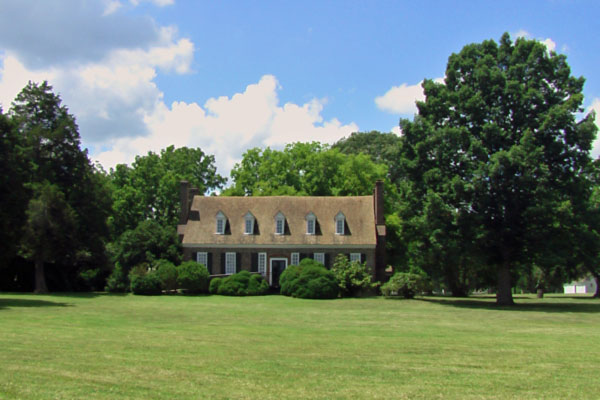
The replica of the big house
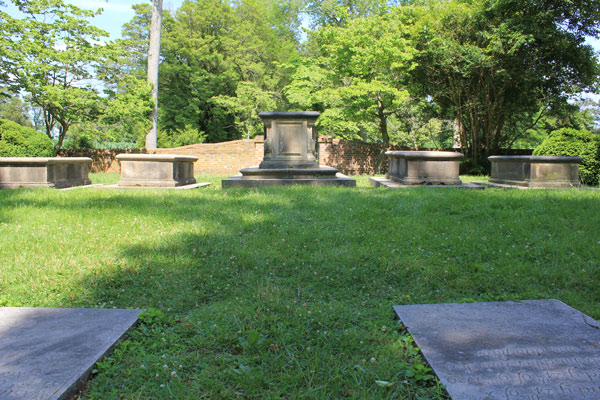
Augustine's grave in the family plot
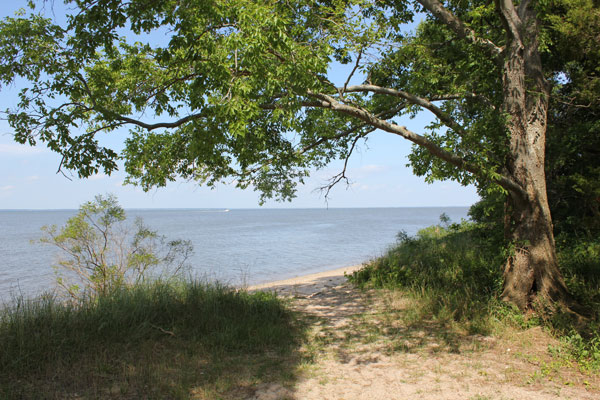
The beach on the Potomac
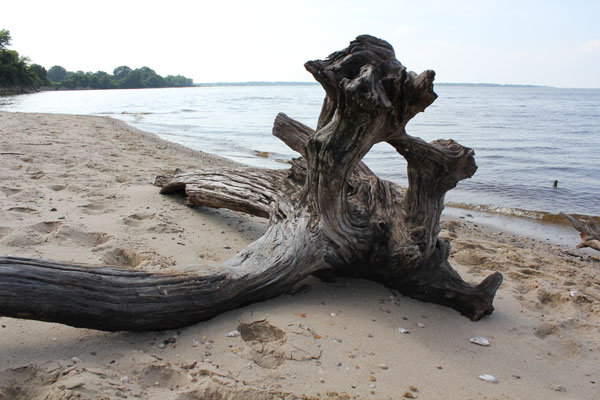
The beach on the Potomac
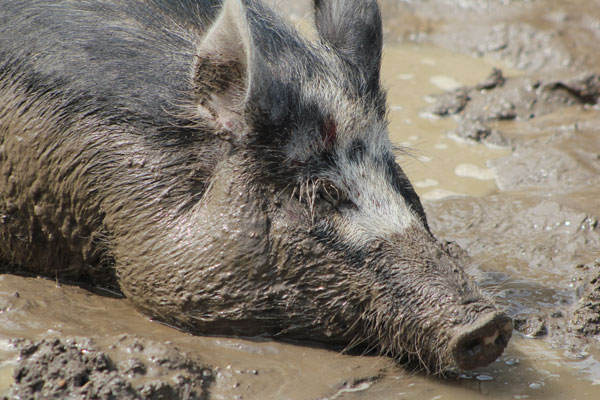
A presidential pig at the demonstration farm
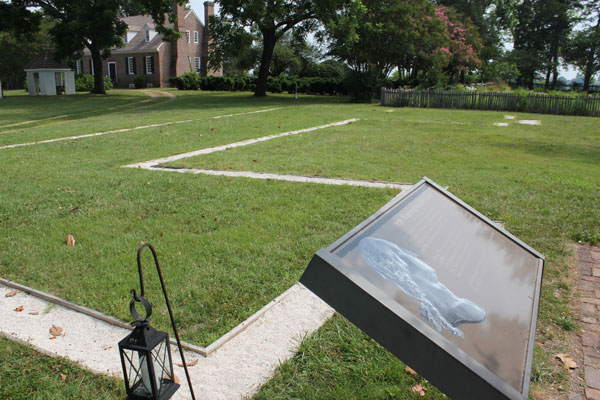
The outline of the foundations of (maybe) the birthplace
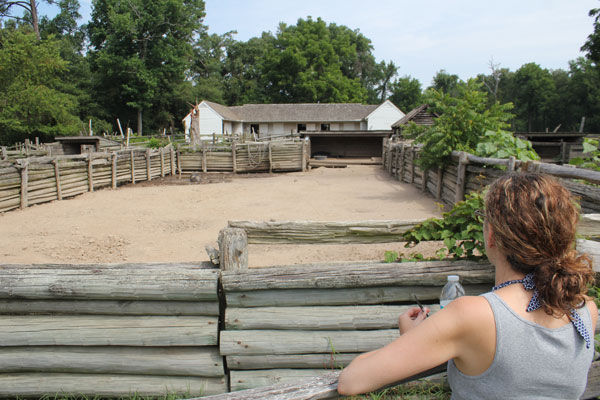
This place is a sty
All great stories start somewhere, and if you believe in the "indispensible man" theory, America's starts at Popes Creek Planatation. From that fertile soil sprang George Washington, and by extension the universal freedoms that will one day spread to the farthest reaches of the galaxy. You should probably visit before the space tourists make it tacky.
Popes Creek is on the banks of the Potomac River, which in the 18th century was a commercial superhighway of Virginia's plantation system. Augustine Washington (a fair-to-middling businessman) bought the property in 1718 and turned it into his primary residence. He was doing all the usual plantation stuff: growing crops, doing morally questionable stuffs with slaves, and impregnating his wives as much as possible. In 1731, Augustine knocked up his second wife, Mary Ball. In February 1732, Mary bore Augustine's fourth son. They named him George, because the Masonic prophecy deemed it so.
And that's really all the Popes Creek history you need. Boy George lived there only until the age of 3 1/2, when Augustine moved his base of operations elsewhere. All the original farm buildings are gone, and there aren't many surviving records documenting his time there. Parson Weems didn't invent any iconic formative episode from the Popes Creek years.
But you still gotta visit! The National Park Service runs the place as the George Washington Birthplace National Monument -- and they never do a bad job. The focal point is the "historic area," a tiny peninsula that sticks out between a marsh and a creek. It has the foundations of the supposed structure where Washington was born; artifacts recovered from that site indicate that the two-year-old George probably smoked a pipe, which would explain a) his lifelong dental problems; and b) the Christmas fire that burned the house to the ground. Before they discovered the foundations of the birthsite in the 1930s, they put up a memorial house where they thought it might have been. It has no significance, but it LOOKS historic, and it gave them something to put on a postcard for a few decades.
A short walk away is the "living history" exhibit, which is what historic sites do when they think school kids will be bored. Personally, I think historic sites are overestimating the entertainment value of 18th century farming techniques, but if the zombie apocalypse ever comes, it's good to know that someone will still know how to turn bovines into candles. And living history farms do give yo7u the chance to see farm animals. And to smell farm animals. And to realize that everyone on an 18th century farm probably smelled terrible.
The real selling point of the property, however, hasn't changed in three centuries. In the 1700s, farmers used the beaches of the Potomac to move their products to market, and bring in the supplies they needed. The plantation system kind of fell on hard times in the 1860s, so the beaches are now free for other uses. The Park Service runs Popes Creek, and it also controls part of neighboring Bridges Creek -- a plantation that was in the Washington family a few generations before Augustine. The beach for Bridges Creek is open for recreation. You can lay out, go fishing, or just walk as far as the tide will let you. Did young George Washington walk that beach in intense contemplation of the rights of man? Absolutely not. But you can!
And on your way out, you can pay some respects. John Washington, George's great grandfather, set up a family cemetery on the Bridges Creek property. They spruced it up in the 1930s, with markers representing George's parents, grandparents and great-grandparents. Like all good farmers, they're nurturing the soil.
Boyhood Home: Ferry Farm, Fredericksburg, Virginia
Visited in 2011.
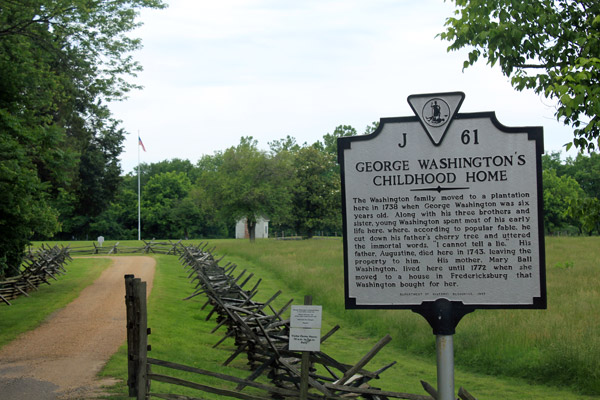
Parson Weems, eat your heart out.
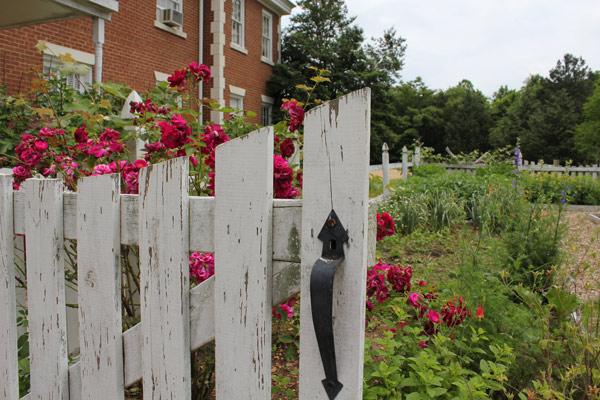
The gardens at the visitors' center.
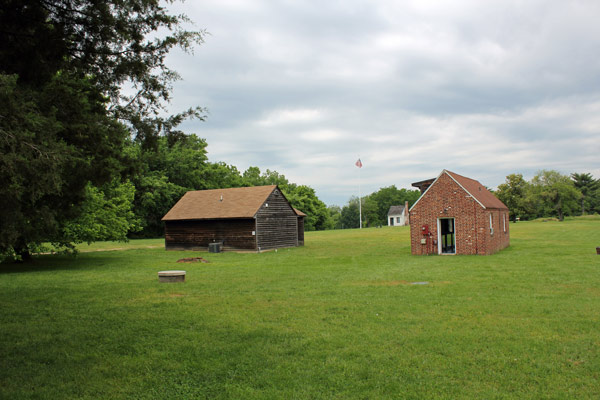
Buildings in a field, etc. etc. and so forth.
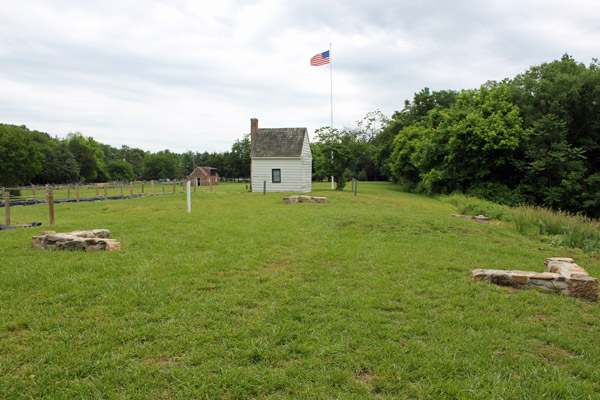
The outlines of the foundation of the boyhood home.
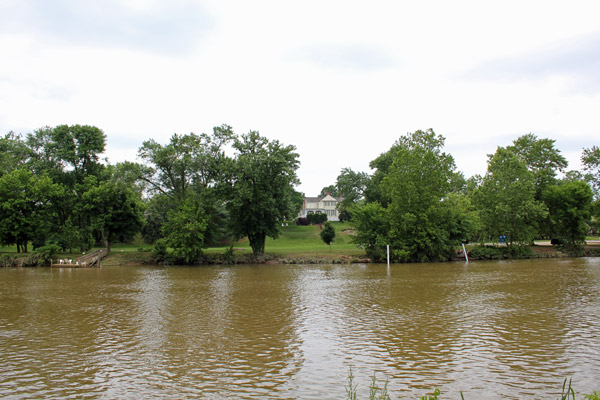
Silver dollars at the ready, lads.
History sometimes requires a little imagination. Ferry Farm was George Washington's boyhood home, but there's no home left. They found a foundation, and they know what was on site. But there's nothing to see except for a few holes in the ground. Archaeology is still in progress, but they aren't pulling the skeletons of George's boyhood enemies out of ancient ditches. Pottery shards can tell you only so much about the father of the country.
But you can visit for the legends! The story about George chopping down a cherry tree is almost definitely a lie, concocted by Parson Weems. But if that lie about never telling lies even sort of happened ... well then, it sort of happened at Ferry Farm! George never threw a silver dollar across the Rappahannock River, because silver dollars weren't a thing back then. But if they had existed, then it would have happened right there at Ferry Farm!
Unfortunately, the good folks at Ferry Farm are doing almost nothing to make folk history sexy. There are no cherry trees on the premisies, and there is no animatronic George swinging an ax. There is no landing on the river where you can try to tear your rotator cuff whipping replica inauthentic silver dollars at the far bank.
But presidential nerds will still like it. George lived at Ferry Farm from ages 6 through 20. After age 11, in wasn't just his home -- it was his inheritance. Augustine, his dad, got the sniffles and died. Augustine left his best properties to George's older half brothers, and the family's sudden drop in cash flow meant that George couldn't get the English boarding school education of his dreams. But Ferry Farm was left to him, as soon as he came of age.
That arrangement apparently made George's teen years very awkward. He had to live under his mother's thumb, and Mary has been described as a difficult and controlling woman. George wasn't counting on getting the farm cleanly when the time came, so he planned to make some extra income.
He found some old surveying tools in a shed at Ferry Farm, practiced that craft and eventually found survey work out west. When he joined the Virginia militia in his early 20s, his experience in the western wilderness was a huge asset; it put him in position to be a player during the French and Indian War. That experience put him in a great position to run the Continental Army. So while nothing super sexy happened at Ferry Farm, you can argue that Washington's experiences there are the reason we drive on the right.
There's a little post-George history, too. Long after the property left the Washington family, it was used as camp for Union troops hoping to capture Fredericksburg during the Civil War. The ferry launch (which the Washingtons never owned, and were quite annoyed by) was the site of a pontoon bridge for the Union's attempts to cross the Rappahannock.
Today you can enjoy a respectable visitors center, some markers showing where foundations were and a little nature walk along the river (I saw a beaver). It's a pleasant couple of hours. If you're down in Fredericksburg and you love America, you should check it out. And if you don't love America, go to Russia.
Fort Necessity, Farmington, Pennsylvania
Visited in 2013.
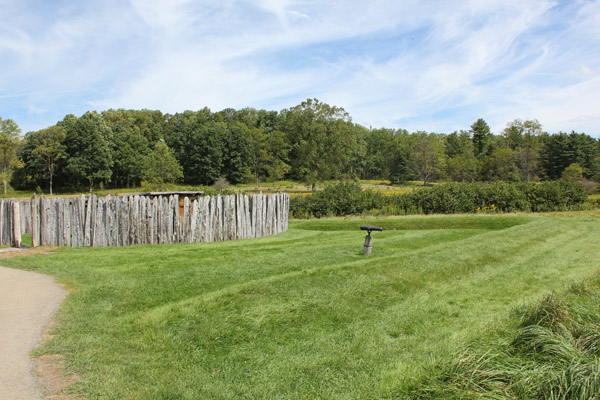
Hard to believe they lost, huh?
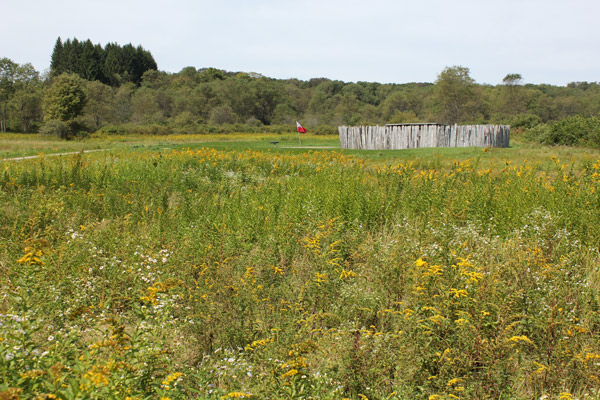
It looks pretty without the piles of dead bodies.
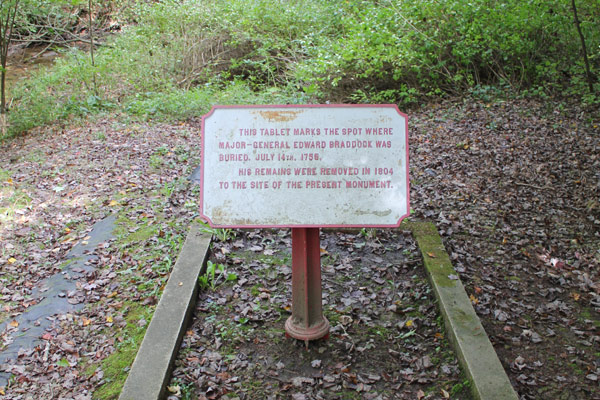
Braddock's original grave, in the middle of Braddock's road.
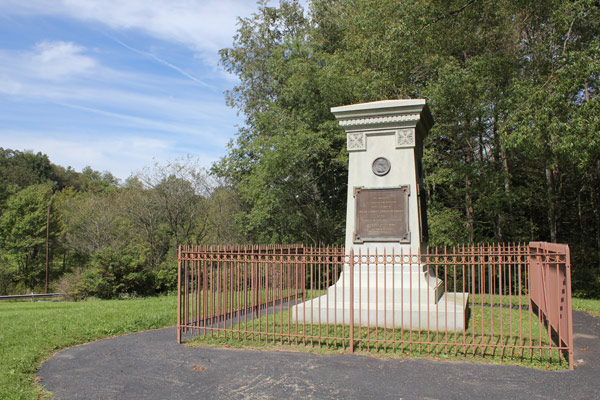
The modern-day Braddock grave marker.
We all make mistakes in our 20s, whether it's sleeping with the wrong person, taking the wrong job or clinging to our teenage selves. George Washington started a world war. He probably also made out with some uggos, but the world war is what we're focusing on right now.
The year was 1754, and the French and British had been arguing about who controlled the land around the Ohio River. The French had recently built a fort near modern-day Pittsburgh, which meant that brunch places and topless cabaret theaters were on the horizon -- and under international law, any country establishing such institutions would have a morally superior claim to a region. So Washington was put on road-building detail, to help Virginians populate the savage hinterlands of Pennsylvania as quickly as possible. Riding ahead of the bulk of his troops, he heard rumors of a small French force in the vicinity of the "Great Meadows" region. A helpful Seneca chief led him to the Frenchmen, who were resting peacefully at the time.
George did exactly what you'd expect of a man with his noble character. Since the French and British were not at war, he gathered his men, surrounded the French position, and tried to slaughter them all in their sleep.
Ah, youth!
You were probably expecting more from a man with so many mattress sales in his honor, but sometimes the natural order of things can't be denied. Not even George Washington could overcome the biological impulse to be a huge d-bag in his early 20s. Sure, he had his reasons for attacking, in the same way that you might have your reasons for ending a four-year relationship via text message. They weren't particularly great reasons.
Even so, murder ended up being a great career move for George, in a roundabout way. Among the French dead was their commander, Joseph Coulon de Villiers, Sieur de Jumonville. Jumonville's officer brother was stationed nearby, and within a few days he was ready for revenge. Washington, who was extended way past any significant reinforcements, came to the logical conclusion that some s*** was about to go down. He had his troops build a palisade at Great Meadows, dubbed it Fort Necessity, and hoped for the best.
You can now visit a replica of that fort, which is a great reminder of how ridiculously small America used to be. It's a circular structure, consisting of unfinished logs driven into the dirt. There's a small cabin in the middle which was meant to hold food, booze and weaponry. There were a few trenches nearby which held the bulk of Washington's 400 or so troops. When the French showed up with 700 guys on July 3, they set up in the trees around the fort -- Washington built it too close to the edge of the woods -- and sniped at the British all day in a steady rain.
George surrendered late that night and, unwittingly, signed a document where he admitted to assassinating Jumonville -- apparently he didn't have a good translator on hand. Under the terms of the surrender he had to take his remaining men and march them back to Virginia. This is sometimes described as the precipitating event of the Seven Years' War, a conflict that spanned a whole bunch of continents. England and France had been pissy with each other a few years, and something was going to set them off; Washington's backwoods massacre seemed to do the trick.
And it all worked out for Washington. About a year later, he was the Virginia militia officer riding along with Gen. James Braddock, who was supposed to be capturing Fort Duquesne. Braddock got ahead of his reinforcements, was ambushed by the French and took a bullet. Washington took over on the battlefield and kept his troops organized throughout the retreat. His bravery that day became the foundation for his future military career. He had Braddock buried in the middle of the road that he had started the year before, in an unmarked grave. The remains were eventually moved to the side of the road (which is the modern-day U.S. 40) and topped with a nice marker. It's about a mile away from the rebuilt Fort Necessity.
The moral: Don't be afraid to make mistakes. Washington was looking to make a name for himself, and to do it, he was willing to gun down a bunch of guys in the woods. That made his overwhelming defeat at Great Meadows possible and started the world war that would allow him to become a military hero -- by leading a retreat from another awful loss. And as a military hero, he was able to lead the American Revolution and enter our national folklore as the kind of guy who would never, ever gun down a bunch of guys in the woods. Fortune favores the bold. Put another way:
I don't know about you
But I'm feeling 22
Let's massacre some Frenchies
Make them say sacrebleu
Mount Vernon, Fairfax County, Virginia
Visited in 2007, 2008, 2013 and a bunch of other times.
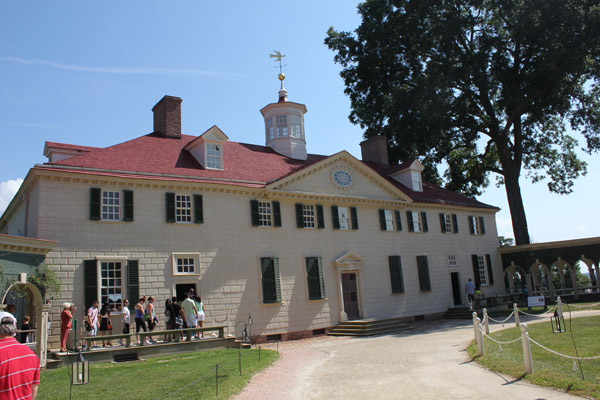
The house that love (and probably slave labor) built.
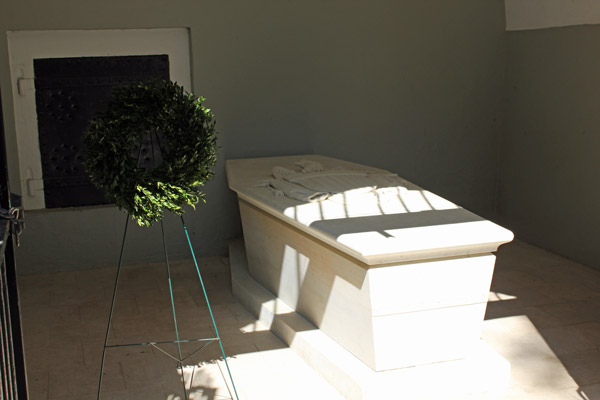
Inside Washington's tomb. Less creepy than you'd think!
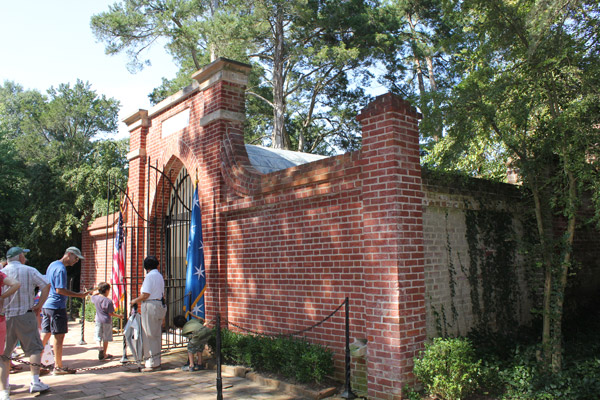
The exterior of the Washingon tomb.
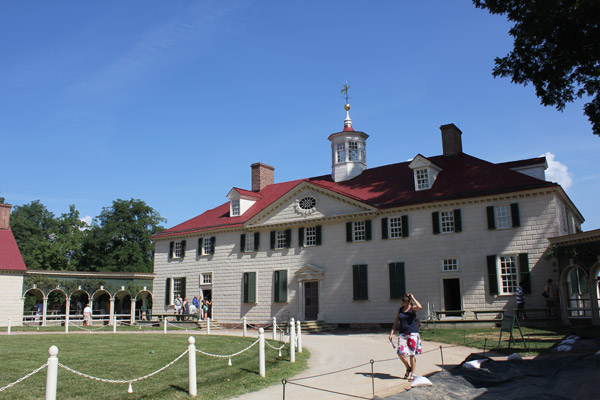
A reverse angle of the house, because I'm fancy.
They call George Washington "The Indispensable Man," and here is what they mean:
Thomas Jefferson greeted White House guests in his pajamas. He had a terrible sense of humor, and though he fancied himself an innovative farmer he died buried in debt. Benjamin Franklin was pushing 70 when the revolution started, and for all his mental acumen he was never going to figure prominently in the new nation. What with the syphilis and all. John Adams was lawyer by trade and had limited political acumen; he was so manipulated by Alexander Hamilton that his policies fractured the political class into two separate parties. James Monroe held grudges to a fault, thought he was better than almost everyone else and died penniless. James Madison, for all his intelligence, was often considered insufferable and ineffectual as a commander-in-chief. He died broke.
When you inventory the Founding Fathers, when you think about the fate of America, you realize it wouldn't have happened without George Washington. It's the same dynamic in every office in the world: Idea men are worthless without someone to get s**t done. It's one thing to say everyone deserves sausage. It's another thing altogether to actually make the sausages and hand them out. George Washington was a sausage-maker hander-outer. And the name of that sausage was AMERICA. YEAH.
When you check out the operations at Mount Vernon, you'll see what I mean. Adams was a farmer, Jefferson was a farmer, Monroe was a farmer, Madison was a farmer. George Washington, however, was a VERY SUCCESSFUL farmer. He knew how to run a business. He was a practical innovator. His estate was a model of efficiency. When all his contemporaries were dying broke, George was worth half a million, back when half a million was not just the down payment on a one-bedroom condo in the D.C. area. He was growing wheat when everyone else was killing the soil with tobacco; he was running the land's largest distillery when a young nation was itching to get hammered out of its gourd.
And Washington excelled at much more than farming. He had solid military command experience from the French and Indian War, a knowledge of the land from his days as a surveyor, and enough experience as an elected official to hold his own. The guy was THE celebrity of the 18th century. He could have been king if he wanted, but he had the judgment to walk away from the spotlight TWICE -- retiring his military commission after the war and stepping away from the presidency after two terms. The man was a leader.
Let's put it this way: You know how you have that one friend who knows how to fix his own car, built his own deck AND somehow has $100,000 in a retirement fund at age 29 even though you eat most of your meals off a folding card table and can't pay the minimum on your credit card? Washington was that friend. For a whole nation.
George had a long history with Mount Vernon. He lived on the estate briefly as a young boy, when his father was still alive. He returned there in his early 20s, managing the property for his older brother. By his late 20s he had full control of the property, as well as a massive fortune acquired by marrying the widow Martha Custis. (Marrying rich widows: It's what winners do.) And he expanded the footprint and operations of the plantation repeatedly throughout the rest of his life. Washington spent lots of time away from his home, thanks to his military and government service. But it was always on his mind, and he made a conscious effort to define himself foremost as a gentleman farmer. Mount Vernon was his greatest assest in that regard.
The Mount Vernon Ladies' Association has been running the site for a loooooooong time, and they have refined the visitor's experience a great deal over the years. You'd be hard-pressed to find a slicker operation at a presidential site. Sometimes it's a little too slick; the site is so popular that in the busy times you'll barely get to see the residence. In those situations becomes a "cattle chute" experience, where a stream of people shuffle through the structure and docents stationed in each room barely answer your questions. (Even the important ones, like "Would you validate my existence by telling me how thoughtful I am to ask about the patterns on the dining room wainscoating?")
But it's something else to see the rooms where he dined, the bed where he died, the guest rooms where the 18th-century equivalents of the Rat Pack stayed ... The first presidential chair is in his home office. That's gotta be the closest we've come to a throne in this country.
And there's much more than the house -- the outbuildings are pretty cool. There's a "pioneer farm" that demonstrates some of the agricultural techniques of Washington's day, right down to the composting heap. They definitely make the effort to tell the story of slavery at Mount Vernon -- which is good, because Washington had more slaves than any other president and it's hard to ignore. There's also the wharf on the Potomac where Washington shipped out his goods, a forest walk, George and Martha's tomb, and a swanky visitor center and museum. A few years back they incorporated disturbingly lifelike statues of Washington that were made with science and stuff. They don't talk, like the much cooler statue at Disney World, but it's still impressive.
If you get the chance (it's seasonal) go three miles down the road to Washington's mill and distillery. If you owned a mill back in the day, you were a big shot -- it was actually the law that you couldn't hog it all for yourself, but instead you had to rent out milling time to your neighbors. So yes, Washington was a wheat pimp. Both the mill and the distillery are reproductions, but they're functioning -- so you get a chance to see 18th-century technology in action. The distillery was at one point the biggest whiskey-making operation in the country, run by Washington's Scottish estate manager. They finished rebuilding in 2007, and now they're cranking out hooch for anyone who wants to partyFOUNDING FATHER STYLE. That means we shoot our flintlock pistols into the air when we're drunk, and then send couriered notes on parchment to our ex-girlfriends. Now, you are wondering: if Washington was planning on going into the whiskey business later in life, does that explain the crushing of the Whiskey Rebellion in 1794? OF COURSE. It was all part of Washington's evil business plan, which you will understand perfectly if you a) drink a fifth of whiskey and b) then read some very persuasive websites I can direct you toward ...
Also seasonal, and also worth it: There's usually a window in the winter when they open the third floor of the mansion to visitors. Because of the fire code and whatnot, the top floor is inaccessible to the public most of the year. But no one has ever died in a mansion fire in the winter, so they pick a week and risk it.
And why visit the third floor? We've all heard the rumors about George Washington's secret brain-damaged man-child, manacled to a wall in the attic away from company and forced to eat rats for sustenance. And yes, we've all wondered if maybe Washington didn't die of a throat infection, but in fact had his jugular torn out after hitting Bruno with a riding crop one time too many. But they don't show you that room, or even the secret door behind a portrait of John Paul Jones that would access it.
Instead, you get to see the lader up to the cupola, some storage rooms, some spare bedrooms, and one very interesting chamber: Martha's bedroom. After George died in 1799 (really, he got the sniffles while riding the Mount Vernon grounds), Martha shuttered their bedroom and moved to the third floor, staying in a smaller, darker room until her own death two and a half years later. If I heard right they have the original furniture and drapes still in the room. We don't really mourn people the way we used to, nor do most of us have mansions big enough to go around shuttering rooms. So to see her old room (spacious, bright, decorated) compared with her new room (cramped, dark, spartan) it really is a striking demonstration of what she must have been feeling without George. (Or Bruno, who was of course put down after killing George.) To steal a factoid from one of the guides, David MacCullough called Mount Vernon the autobiography Washington never wrote -- you get a remarkably solid idea of the man from the plantation and how it ran. Looks like you can learn something about Martha too.
And if you think you might make it back within the year, go for the annual membership. Not only do you save money, but you get a Mount Vernon photo ID. And let me tell you, it opens doors with the ladies.
Inauguration Site: Federal Hall, New York City
Visited in 2008.
For 400 years New York has been devouring itself; a necessity brought on by the laws of real estate that has, over centuries, become a philosophy for living. The new springs forth on top of, underneath, next to and inside the old.
There are pockets of the past that survive. In 1789, New York was the bustling heart of a new and confused nation, though hardly the concrete island we imagine today -- what mattered of Manhattan ended before the numbered streets. (20th St. was a rural suburb at Teddy Roosevelt's birth in 1858; when his father moved the family far from the madding crowd in 1878, it was to the pastoral quiet of 57th St.) After a decade of post-Revolutionary muddling, the Constitution was finally in order, the Congress assembled. Just one piece of the puzzle remained, and so on April 30, General George Washington (retired), who had declined the titles of king and emperor, left his New York residence and proceeded with much fanfare to Wall Street.
At Federal Hall, a venerable meeting place where colonials had debated the Stamp Act and the seeds of the First Amendment had been planted in the years before the war, Washington ascended to the balcony of the first capitol. There, in front of his countrymen, he placed his hand on a stout leather-bound Bible and took the oath which officially made him the first president of the United States of America.
That building is gone. But the slab on which Washington stood that day remains, as does the Bible -- and both are on display in the Greek temple which stands on the spot, a building that has served as an office, and a Treasury vault, and now a museum. It's a shrine to the birth of American democracy, just across the way from a shrine to capitalism (the New York Stock Exchange), and on the steps outside you can still see Washington -- but twice the size, cast in metal, forever with his hand outstretched as though reaching for the Bible once again.
It's still Manhattan, though. From the inside, depending on the window, you can see into the building next door, where professional-looking people in expensive-looking spandex work out on treadmills in a room with too much wood paneling to have so many treadmills. And if you head west, within minutes you reach the site of the World Trade Center. At the time I visited, it was mostly a hole in the ground. A cleaner, tidier hole with glimmers of progress, but still a hole. Standing and staring for a few minutes, I noticed not just the destruction, but the people around it -- for every person contemplating the gaping void where two of the greatest feats of modern engineering stood, where thousands died, there are ten people strolling past seemingly without a second thought. Talking on cell phones in five different languages, lost in their own lives. Maybe they stopped and stared at one point, but then, not even seven years later, it was back to being a city block for many. The history isn't gone, but in New York, where everything is demolished and rebuilt eventually, maybe it's easier to let go.
Strange, then, that just a block from there stands St. Paul's chapel, a colonial-era parish. It is the oldest continuous-use public building in the city. The church has survived fires, and age, and on Sept. 11, the flying rubble of the the towers; it became a shrine to fallen rescue workers in the weeks that followed the attack, as well as an operations center for those still combing through the rubble. It functions today not just as a church, but as a museum -- and not just to the rescue workers, but to America's past. George Washington worshipped at that church. He had a private pew (it served as a station for rescue workers to have their feet rubbed in 2001); and on April 30, 1789, he attended services there on his first day as president.
He might have gone to services that day at Trinity, the "home office" for St. Paul's, just blocks away on Broadway. But that building had been destroyed by fire, and was in the process of rebuilding (in New York, a given). It was finished after New York had stopped serving as our capital (the government moved to Philadelphia in 1790, then the newly built city of Washington). Today the church and its graveyard still have their honored space in the heart of the financial district, and businessmen who give it no second thought walk every day within feet of the grave of Alexander Hamilton -- the Treasurer who may have made their careers possible; the father of the political party in America; a man who would probably have mixed feelings on the availability of jumbo soft pretzels within 200 feet of his final (courtesy of Aaron Burr) resting place. Engineers building on the World Trade Center were within blocks of the crypt of Robert Fulton, the inventor and engineer whose work with steam engines helped make New York into the port that could one day sustain those towers.
We live beside history, and underneath it, and on top of it as well. On an island of millions, moving forward sometimes means ignoring that history -- or at the very least, not being held in its thrall. The resilience that makes Manahattan possible comes with the price of sometimes forgetting the things that made Manhattan great. But pockets do survive, if you want to take an afternoon to remember.
Deshler-Morris House, Philadelphia, Pennsylvania
Visited in 2008.
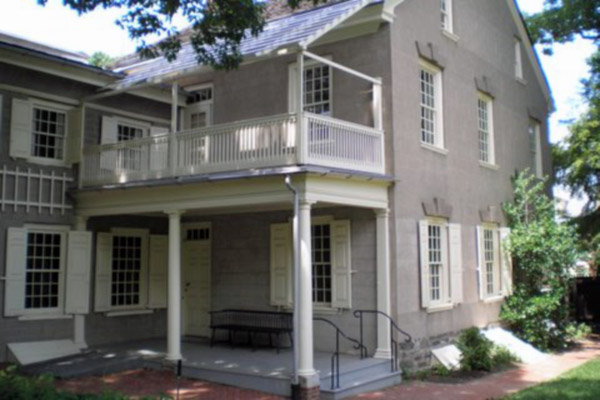
A very classy summer rental.
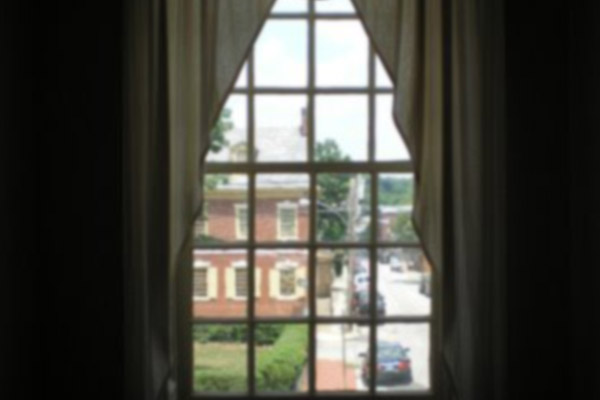
Beautiful views of corpse-free streets!
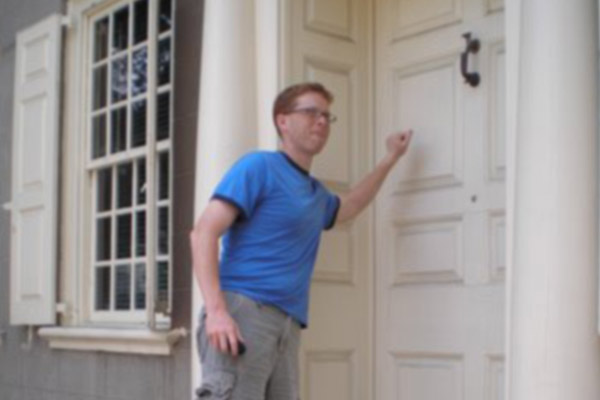
Jefferson plays ding-dong ditch: A re-enactment.
Philadelphia was not always the dazzling urban oasis that you see today. In the 1790s, when Philadelphia was serving as the nation's capital, there was a slight problem with corpses. There were hundreds of them piled in the streets. Yellow fever was a mild impediment to good governance, so George Washington took his federal business elsewhere: scenic, wild and wonderful Germantown! Just six miles away, it had everything you look for in a summer capital: fresh air, no blistering bodies, and a garden where Martha could tinker around for a few weeks.
The "Germantown White House," aka the Deshler-Morris House, was a furnished rental. It was also a place that Washington was familiar with. A few years earlier, the battle of Germantown featured the house as a kind of pivot point for the British lines. The British commander even used it as an HQ as the battle, so the home was more than just a summer rental. Using it was sweet revenge against the limey bastards who licked him but good. Imagine one day entertaining guests in the home of the guy who gave you swirlie in high school. Same thing.
Plus, unlike some summer capitals, it actually saw some political use. Washington held Cabinet meetings in his two summers at the house, and so Thomas Jefferson and Alexander Hamilton graced the parlor on more than one occasion. That's vacation for you: bitter political enemies, sharing some brewskis and watching the summer bunnies roll by the front window. Sometimes Hamilton would wax his Camaro out front while Jefferson manned the grill. Imagine mobilizing troops against whiskey distillers, or avoiding war with France, but at your beach house. Same thing.
The point is, it's a quaint little slice of American history. The furnishing you see today isn't original, but the building has been renovated to its 18th century splendor, with spacious rooms and checkered hallways and a sweet garden lawn. The National Park Service is in charge, so they have a pleasant little museum display and some volunteers with fun stories. For instance, because Pennsylvania law called for the emancipation of any slave who stayed too long, George had to send his servants back to Mount Vernon in shifts. Fun! And George would often send his chief slave, Hercules, into the fever-ridden downtown to pick up dinner on cheesesteak Fridays. True, I swear!
Germantown itself has gotten a little scary, but do stop by if you have the chance. I stopped in on Father's Day, with my mom and dad in tow, and we're all still giddy about the experience many years later. Or at the very least, I'm giddy, and they've learned to tolerate my moods. Of all the executive residences, the Deshler-Morris house is the oldest one left -- the homes from New York and downtown Philly are long gone, with no replicas built just yet. Congress didn't meet in the summer back then, so that rental house was the undisputed center of American authority for months at a time. That's worth the price of admission, isn't it?
Yes, because it's free.
The (Other) Washington Monument, Boonsboro, Maryland
Visited in 2008.
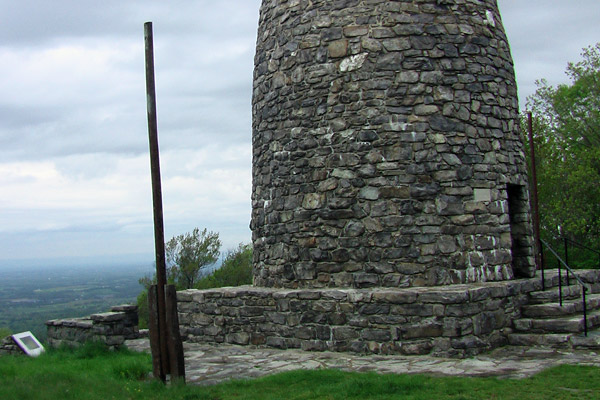
I swear, THIS is the Washington Monument.
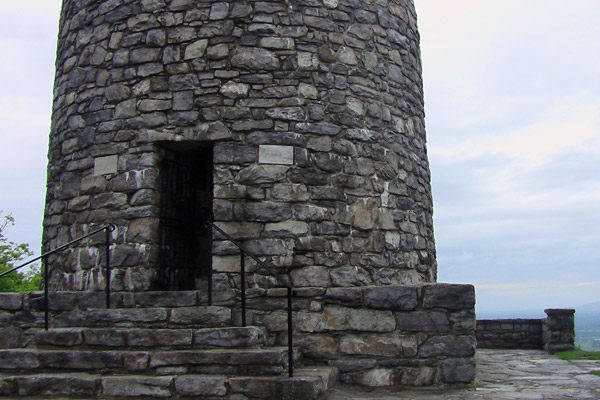
Seriously, it's the Washington Monument!
For about 10 years, I drove past a road sign on I-70 indicating the exit for the Washington Monument. It is many, many miles away from the National Mall. It was bothersome. And after 10 years, I finally drove past at a time when I had nowhere to be.
And that's why I now know the truth: The ORIGINAL Washington Monument was built by the people of Boonsboro in 1827, and from what I can gather they did it barn-raising style. Everyone in the town walked up the local mountain, threw down a few drinks and built a 15-foot tower to honor our first commander in chief. They did this right around Independence Day. They came back later and built it up to 30 feet a few weeks later, when it was widely agreed that everyone in town was bored and had nothing better to do.
The original structure fell into a crap-like state twice, then got restored in the 1930s, probably as a make-work project during the Great Depression. The simple tower honors Washington by embodying his ... uh ... round stoniness. The Appalachian Trail now runs straight by it, so that all granola-munching eco-snobs with an REI membership and lots of vacation time can marvel in the glory that is GEORGE WASHINGTON.
The view from the top of the tower is really impressive, and the drive through the surrounding countryside is great. I'm not sure I'd tell you to go out of your way to see it, especially when Washington Monument 2.0 represents a slight upgrade. But if you have a freakish obsession with the presidents, this is totally in your wheelhouse. Go for it.
George Washington Masonic National Memorial, Alexandria, Virginia
Visited in 2011 and 2017.
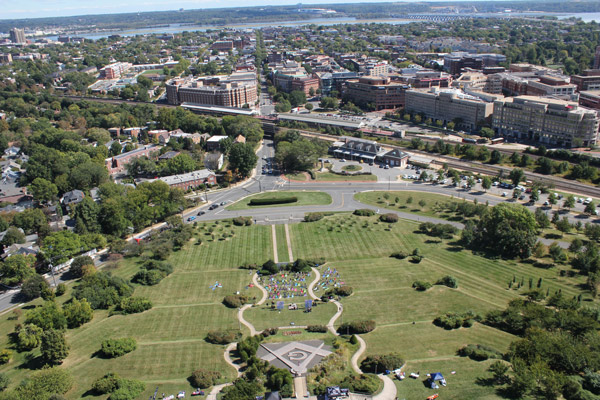
Can you find the ley lines?
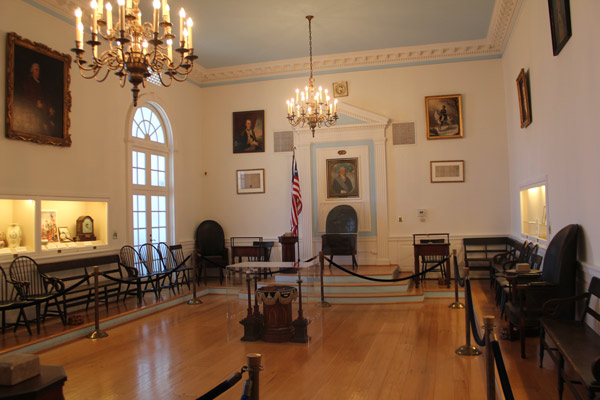
The re-creation of the Alexandria lodge.
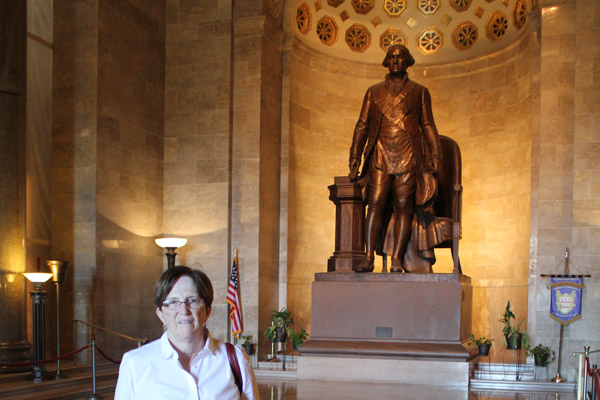
George Washington, lobbyist.
On the day I was finally eligible to run the government -- my 35th birthday -- I decided to learn about running the government. And so I went the George Washington Masonic National Memorial.
As you may have read in many reputable blogs, soiled pamphlets and Dan Brown novels, the Freemasons have been controlling international geopolitics since the Jurassic era. Masonic aliens used their seismic cannon to set off the climate-changing volcanos that killed the dinosaurs, then planted "human" DNA into the ecosystem. Since that day, they've been hiding in the moon's shadow as they cultivate humans to be hunted for sport on their home world. A select few aliens are given human appearances so that they can better shepherd us in person; these "people" are known as Freemasons.
All you're going to get at the Washington Masonic National Memorial is the cover story, of course: the masons were Medieval stoneworkers who traveled the land building cathedrals, eventually starting a professional guild that incorporated a moral code. Over time that evolved into small groups of old white guys in funny hats riding motorized wheelie-popping trikes at Memorial Day parades. The point is, there's lots of confusion and mystery surrounding the masonic organizations, who keep lots of their rituals hidden from the public eye, except for the wheelie-popping trikes. Let's see if we can clear some of that up.
The first thing to understand: everyone was once a freemason. The reason so many U.S. presidents were masons, according to our guide, is that 25 percent of white males in 18th-century America were Freemasons. There were no bowling leagues, and women could go to church with you. So Freemasonry was your best bet for getting out of the house for a few hours to flip through a copy of Colonial Jugs with your buddies. Since that time, most masonic organizations have grown at a crawl compared to their competition -- probably because you don't have to sacrfice a beloved bet to join most intramural soccer leagues.
The various symbols of freemasonry also aren't as creepy as you're thinking. For example, the "square" (a metallic right angle) was a tool used to make sure that blocks were cut into perfect, stackable units; if you think of people as stackable units, and the square as a way to measure their character, then people with moral right angles can stack into an enormous and strong edifice. This moral edifice can then be used as a defensive structure from which to pour moral cauldrons of moral boiling oil on moral infidels who are attempting to steal the moral alien crystal that is is the source of your moral power. Not creepy in the least, right? Even less creepy are the aprons, which all masons wear as a way to both honor the professional roots of the society (stoneworkers could hold tools in an apron) and to hide embarrassing arousal when checking out a buddy's wife at the regular masonic mixers.
You also must know that not all Freemasons are created equal. George Washington, for example, was a "master mason" -- enough to be the head of his masonic lodge in Alexandria, Va. But in the specialty branches of masonry, he would have been a peon. The Scottish Rite goes up to the 33rd degree, and "master mason" is only the third. Only through hard work and philanthropy, or through being the lodge master's brother-in-law, can you ascend to the upper tiers. The 32nd degree is "Master of the Royal Secret." That is much cooler sounding than the 33rd degree: "Inspector General." But oddly, neither title matches the pageantry of the sixth degree: "Intimate Secretary." Really. In case you're wondering, at least one president did actually get the 33rd degree: Truman was huge into masonry, and he needed the 33rd degree to get nuclear authorization codes from his alien masters.
There's also a "York Rite," which has fewer steps but more-interesting costumes. Gerald Ford was a Royal Arch mason, which is part of the Yorks. Then there are groups like the Shriners, the Tall Cedars of Lebanon and the Mousketeers, which all require members to be master masons before joining. So, when you add it all up, if you ever see a weird clubhouse in a city that no one goes into or exits, it's probably a masonic harem.
As to the actual George Washington Masonic National Memorial: it's pretty cool. Masons the country 'round chipped in their contributions, which were channeled to the Alexandria, Va., lodge that Washington once ran. The temple was built in the 1920s as a way to honor the most famous mason, and in its design it was meant to mimic the reported appearance of the lighthouse at Alexandria in ancient Egypt. Plus, it has cool elevators! There are two, on opposite sides of the temple. At the ground level, they are maybe 60 feet apart, and at the top level they are 8 feet apart. This is because they ascend at a 7 1/2 degree angle.
The entrance hall has a nice statue of George Washington in an apron, two murals depicting masonic scenes from his life, and stained-glass windows of other cool contemporary masons (like Benjamin Franklin). Off of the gift shop, there's a re-creation of the original Alexandria lodge meeting room, with some very interesting swag, such as Washington's original masonic president chair. The highlight for me was the clock that was in the room when Washington died at Mount Vernon. His attending physician, Dr. Dick -- a freemason and member of the lodge -- opened the clock and cut some cords. So for more than 200 years, that timepiece has been frozen at the exact moment Dr. Dick killed George by bleeding him for the 39th time to cure minor flu symptoms. Also on display is the trowel GW used when laying the ceremonial first stone of the Capitol; it is on occasion busted out when a new momentous building is started, or whenever someone must be smeared with quick-drying cement as part of the initiation hazing.
The real draw, though, is the tower. There are nine floors total, each narrower than the last, and the upper floors are decorated in different masonic styles. The Scottish Rite gets the 4th floor, and they installed a tasteful mini-museum dedicated to George and his life. The sixth floor is an off-limits library where the masons store all the personal information they've been gathering on you by using the Patriot Act. And finally, we've got the ninth floor, with access to the outside observation deck (at around 330 feet, I believe). From that height, you might notice some subtle masonic symbols hidden in the surrounding landscape. See if you can find them!
I particularly enjoyed all the inventive and conspiracy-friendly decoration; I also liked that you had to fight a martial arts master of a different discipline on each floor before ascending. You might have heard that the very top of the tower has a radio transponder linked to George Washington's still-living brain, which is transmitting a pacifying telepathic message that keeps most of America as docile lambs, ready for the alien slaughter. If you're going to see that thing, you should definitely earn it with some karate.
Now, personally, I don't buy into conspiracies. But I do enjoy a good coincidence. One of the murals in the main lobby shows Washington and other masons coming to the charitable rescue of some suffering Philadelphians in 1778 -- the middle of the Revolution. Philadelphia is my hometown, so that's cool. Even cooler is the date of the event. My birthday, December 28. THE TRUTH IS OUT THERE.
